Have you met... Dorothée Nilsson Gallery
Have you met... Dorothée Nilsson Gallery

We had the opportunity to meet with Dorothée Nilsson, who opened her space on the gallery-lined Potsdamer Straβe last fall. Arriving at the gallery, its storefront window wrapping around two sides – offering a panoramic view of the bustling street – she first walked us through the current exhibition, which comprises four video installations by Yvon Chabrowski.
The gallery’s third exhibition since its opening, FACES AND MOVEMENTS engages the video medium in different formats – structurally and technically – to immerse visitors within systems of surveillance and recognition, through which bodies and faces are identified, verified and classified. Veiled in a layer of shadow, this confrontation is mirrored by the reflective foil placed over the window from the outside, which enables a view from the inside out, but obstructs the view from the outside in – likewise casting us as participants, as we survey those who are outside, unaware that we are watching.
Each work is positioned in the space in such a way as to compel physical movement. Here, the border between active performance and contained video is troubled, both within and outside of what’s happening on screen. In a two-channel video installation, titled DYNAMICS, two large screens stand propped at an angle, partially enclosing the viewer on adjacent sides. Shot from above, two cameras simultaneously show a group of people, all clad in a muted monochrome palette, as they wordlessly shuffle about an undefined space, navigating between and around, bumping up against and responding to the movements of each other. We are also consumed in this, placed in the midst of the alternatingly escalating and de-escalating crowd. In another installation, meanwhile, we are literally drawn into the frame of the screen, as a camera, detecting only our faces, projects us – as uniform, floating black squares – and registers our movements against a still backdrop of the actual space. Collectively and individually, Chabrowski’s works destabilize the boundaries of the medium – of the screen – and our relationship to it. We hit up against it, are placed inside of it; it fills our space and we come to inhabit it.

We sat down with Dorothée to talk about this interest in testing the limits of the photographic medium, as well as how she got started with the gallery and the other artists and works we should look forward to seeing there.
Can you tell us a bit about your background? How did you get started as a gallerist?
I’ve always been interested in art and I wanted to be educated and do something in that field. I grew up in Sweden and went abroad – to Paris – then Germany. I decided to study economics and I took classes in art history. I moved to Berlin with my family some years after that. I had switched from working in investment banking to working in culture. I met the German/Swedish artist Ann Wolff in Berlin and I started to work for her as an assistant manager. One large project was to start the Ann Wolff Foundation. So that’s how I came into the art scene. From 2010 to 2017 I directed the Grundemark Nilsson Gallery in Berlin, a gallery with a main focus on Swedish photo based artists. The aim was to build up an international platform for Swedish photography from Berlin. After the gallery was closed in summer 2017, I started my own gallery and continued working with most of the artists that we represented.
Is your interest still primarily in showing photography?
I want to extend it. The main focus is still on photo- or camera-based art, but it also includes video art and three-dimensional art, such as sculptures, objects or installations. Many of the artists work in different media that speak to each other. I very much like video art and three-dimensional works – installations, objects or sculptures – even if camera-based.
So, how would you describe the conceptual framing of the gallery program?
The gallery comprises a broad spectrum of approaches, even if there are perhaps two main focuses. One of these focuses would be the examination of the medium itself, to experiment and extend the boundaries, and also use old methods and take them into the contemporary context (as the artists Dawid, Henrik Strömberg and Johan Österholm do). Another focus is the critical reflection on society and social issues (as in the work of artists like the duo Inka and Niclas, Martina Hoogland Ivanow, Julia Perione and Yvon Chabrowski). But there are other artists in the program, such as Sascha Weidner, whose pictures were characterized by perceptions, aspirations and the subconscious. He died in 2015 at only 40 years old, but he was already one of the formative photo artists of his generation in Germany.
I’m also showing very classic black and white photography – by Gerry Johansson, for instance. He just had an exhibition at Kunsthalle Rostock, with two of his series: Germany and Sweden. There’s always one picture of a place, like a social/cultural portrait of it, taken from an outside perspective. I am very fond of his work and I like this contrast – having both video art and analog photography on view at the same time.

Are you mostly working with artists you’ve worked with previously, or have you also brought in new ones? How do you go about that?
I worked with most of them before, but I’ve also started to work with Yvon Chabrowski, and Julia Peirone, which I’m really happy about. Julia Peirone lives and works in Stockholm, Sweden and has been photographing young girls for about 20 years – exploring identity and the photographic image. In this series, she reflects on aspects of childhood and adolescence, such as vulnerability, shame and sexuality. She just had a wonderful exhibition, Girls; Girls; Girls, at Göteborgs Konstmuseum.
What’s your programming like as far as other events – outside of exhibitions?
The Berlin market is not easy, so you have to be on the international fairs. It’s absolutely necessary, in order to get to know collectors, curators, and so on. Otherwise, I also work with institutions to bring the artists into museums and other shows, as well as festivals.
I’m also aiming to have an accompanying event program during exhibitions – for instance, we will have an artist talk by Susanne Holschbach with Yvon Chabrowski on 17 March and then a performance on 24 March. I had also applied for an artist residency with Yvon Chabrowski. The artist studio is located on the rooftop of the Federal Foreign Office in Berlin which is a unique place for it. It's a collaboration between the Federal Foreign Office and the Landesverband Berliner Galerien. So, Yvon Chabrowski will be there from April until the end of June.
Do you have a future direction in mind? How would you like to see the gallery develop?
I want to establish it more and more, make good exhibitions and grow with the artists. I want to show positions that matter and make people reflect and get inspired.

What else is coming up at Dorothée Nilsson Gallery?
Next is a show that opens during Gallery Weekend, with the artist duo Inka and Niclas from Sweden. Their work is an exploration of how the constant stream of landscape imagery influences us, but also in the act of taking a photograph, and the intersections between the photographic and physical realities. There are so many images created everyday; we are bombarded with them through different media. So, when we travel, the images that we want to see are already in our heads. They started looking at this through a series called ‘Watching Humans Watching’, where they traveled to famous landscapes, secretly watching people and photographing them. Then they turned the camera around, asking what the people were looking for – what kind of images they had in their minds – and they started to create these images in nature. It’s a form of performance, happening, or land art-photography, through which they’ve created, or exaggerated, sunsets, for example.
In between, in April I will show an installation by Susa Templin, an artist based in Berlin and Frankfurt/Main working with temporary spaces, interiors and photography. In the fall, I will show Johan Österholm, who’s doing a residency now at Bethanien. He will be in a group show at C/O Berlin at the same time, called ‘Back to the Future’ – an exhibition of artists experimentally re-inventing the history of the photographic medium.
*****
Yvon Chabrowski FACES AND MOVEMENTS Dorothée Nilsson Gallery Through 31 March 2018 Susanne Holschbach in conversation with Yvon Chabrowski Saturday, 17 March @ 5pm CASSANDRA/MOVEMENT PATTERN Live Performance Saturday, 24 March @ 5pm